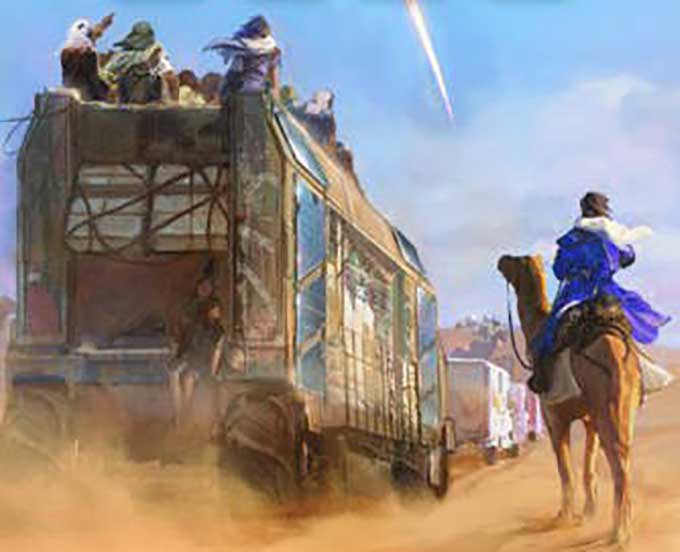Climate science and climate fiction – where data intersects with art

Earth's climate functions as its life support system. That system is under heavy threat from over seven billion people and the bleeding heat of industry: as jungle and forest are rendered into farmland; greenhouse gases belch and fume, destabilizing the environment, shrinking biodiversity, pushing the limits of the Earth's natural mechanisms.
2016 was the hottest year in the modern temperature record. Climate change is a long-term issue on a massive scale - from shrinking glaciers, changes in rainfall patterns, severe heat waves and other irreversible conditions. The worldwide scientific community has issued warnings for years about the present and future impacts of climate change linked to fossil fuel use.
Earth faces unprecedented challenges caused by human agency, yet here we stand, like a deer in headlights, knowing something big and bad is coming, too dazzled to do anything to stop it.
Science fiction has long been the literature that speculates on scientific change while reflecting contemporary societal concerns.
Climate change is happening now, and we need a literature of now to address its issues. As glaciers melt, corals bleach, typhoons kill and forest fires rage, a new genre called climate fiction has emerged from science fiction to stand out on its own. Climate fiction focuses on anthropogenic climate change rather than natural unstoppable ecological catastrophes, such as supervolcanos, solar flares or large, Earth impacting meteorites. And most importantly, climate fiction uses real scientific data to translate climate change from the abstract to the cultural, enabling readers to vicariously experience threats and effects they might be expected to encounter across their own lifetimes.
Climate fiction highlights the hard-impacting economic and interpersonal realities of climate change. It encourages us to understand that climate change is a problem we have brought upon ourselves and that changes to our economic and energy systems are required if we are to survive it.
Climate fiction straddles genre boundaries: science fiction, utopia, dystopia, fantasy, thriller, romance, mimetic fiction, nature writing, and the literary, from fast-paced thrillers, to inward looking present day narratives.
Climate change is emerging as a set of philosophical and existentialist problems as well as physical challenges. It is yet to receive the crisis response and treatment it deserves from world leaders.
 Cat Spark's Lotus Blue is available for pre-order on Amazon.
Cat Spark's Lotus Blue is available for pre-order on Amazon.Fiction - and indeed all art -- has a role to play, by humanising the effects of climate change; by illuminating the human dimensions of technological futures; by encouraging people to challenge ingrained confirmation bias and become climate voters -- active on the issue, making their views known loudly to politicians.
Storytelling has the power to give climate change a human focus by translating complex and evolving scientific concepts into tales reimagining human interactions with the world. Non-didactic, people-centric narratives stressing the social aspects of climate change as much as the technical and scientific encourage societal long-term thinking about the power and potential of clean energy. Climate fiction's growing popularity proves that we desire narratives showing how we might adapt to a changing world as ice melts and seas rise. Stories appealing to social ethics, questioning established hierarchies, and addressing our responsibility for fashioning an ecologically sustainable future.
The coming decades will see problems of increasing complexity, such as permanent political and social instability, dangerous weather, food and water insecurity, and an increase in displaced persons as more and more land is swallowed by the sea. Climate fiction tackles these topics, detailing the practical domestic implications of carbon rationing and renewable energy, and exploring how practical changes might be implemented across ordinary lives. Some climate fiction stories investigate nascent technologies and their integration into business and culture, questioning how far our growing dependence on technology might end up detrimentally estranging us from nature. The topics are wide ranging, and use topical, political and scientific bases, ensuring that while it feels like fiction, it is applicable to current events and daily life.
While much realist and literary fiction continues to focus inwards on individual identities and challenges, climate fiction takes on the task of envisioning physical and cultural landscapes facing uncertainty through processes of transformation and adaptation. Climate fiction forms a bridge connecting scientific information with people preparing to face an uncertain future the past can no longer be relied upon to guide us through.
Art possess inherent empathetic value. Entwined with technological and social change, climate fiction functions as a universally understandable language while serving as a catalyst for forging new trans-disciplinary alliances, shifting debates and values, inspiring and motivating legal and institutional action, opening hearts and minds to new ways of thinking, encouraging resilience, resistance and resolve while continuing to imagine possible futures.
More than anything, we must learn from these possible climate fiction futures, rooted in what we scientifically know today -- if we actually believe such futures might conceivably come to pass. Based on the science, those futures are closer than we think.
Cat Sparks, author of the upcoming novel Lotus Blue, available from Talos Press, an imprint of Skyhorse, in March 2017.